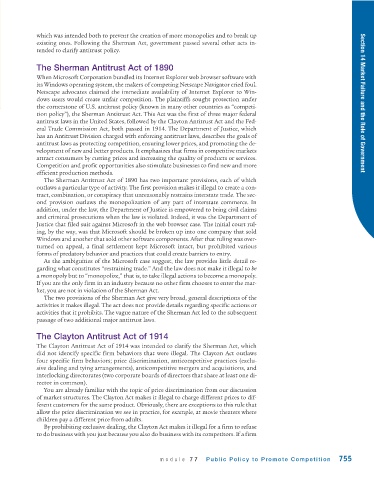Page 797 - Krugmans Economics for AP Text Book_Neat
P. 797
which was intended both to prevent the creation of more monopolies and to break up
existing ones. Following the Sherman Act, government passed several other acts in-
tended to clarify antitrust policy.
The Sherman Antitrust Act of 1890
When Microsoft Corporation bundled its Internet Explorer web browser software with
its Windows operating system, the makers of competing Netscape Navigator cried foul.
Netscape advocates claimed the immediate availability of Internet Explorer to Win-
dows users would create unfair competition. The plaintiffs sought protection under Section 14 Market Failure and the Role of Government
the cornerstone of U.S. antitrust policy (known in many other countries as “competi-
tion policy”), the Sherman Antitrust Act. This Act was the first of three major federal
antitrust laws in the United States, followed by the Clayton Antitrust Act and the Fed-
eral Trade Commission Act, both passed in 1914. The Department of Justice, which
has an Antitrust Division charged with enforcing antitrust laws, describes the goals of
antitrust laws as protecting competition, ensuring lower prices, and promoting the de-
velopment of new and better products. It emphasizes that firms in competitive markets
attract consumers by cutting prices and increasing the quality of products or services.
Competition and profit opportunities also stimulate businesses to find new and more
efficient production methods.
The Sherman Antitrust Act of 1890 has two important provisions, each of which
outlaws a particular type of activity. The first provision makes it illegal to create a con-
tract, combination, or conspiracy that unreasonably restrains interstate trade. The sec-
ond provision outlaws the monopolization of any part of interstate commerce. In
addition, under the law, the Department of Justice is empowered to bring civil claims
and criminal prosecutions when the law is violated. Indeed, it was the Department of
Justice that filed suit against Microsoft in the web browser case. The initial court rul-
ing, by the way, was that Microsoft should be broken up into one company that sold
Windows and another that sold other software components. After that ruling was over-
turned on appeal, a final settlement kept Microsoft intact, but prohibited various
forms of predatory behavior and practices that could create barriers to entry.
As the ambiguities of the Microsoft case suggest, the law provides little detail re-
garding what constitutes “restraining trade.” And the law does not make it illegal to be
a monopoly but to “monopolize,” that is, to take illegal actions to become a monopoly.
If you are the only firm in an industry because no other firm chooses to enter the mar-
ket, you are not in violation of the Sherman Act.
The two provisions of the Sherman Act give very broad, general descriptions of the
activities it makes illegal. The act does not provide details regarding specific actions or
activities that it prohibits. The vague nature of the Sherman Act led to the subsequent
passage of two additional major antitrust laws.
The Clayton Antitrust Act of 1914
The Clayton Antitrust Act of 1914 was intended to clarify the Sherman Act, which
did not identify specific firm behaviors that were illegal. The Clayton Act outlaws
four specific firm behaviors; price discrimination, anticompetitive practices (exclu-
sive dealing and tying arrangements), anticompetitive mergers and acquisitions, and
interlocking directorates (two corporate boards of directors that share at least one di-
rector in common).
You are already familiar with the topic of price discrimination from our discussion
of market structures. The Clayton Act makes it illegal to charge different prices to dif-
ferent customers for the same product. Obviously, there are exceptions to this rule that
allow the price discrimination we see in practice, for example, at movie theaters where
children pay a different price from adults.
By prohibiting exclusive dealing, the Clayton Act makes it illegal for a firm to refuse
to do business with you just because you also do business with its competitors. If a firm
module 77 Public Policy to Promote Competition 755

